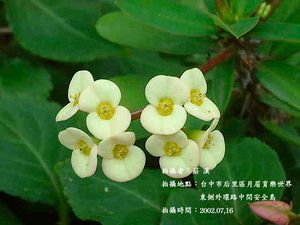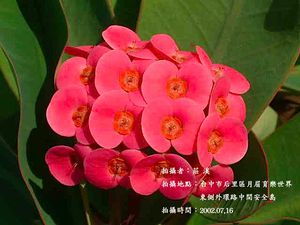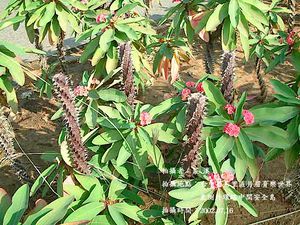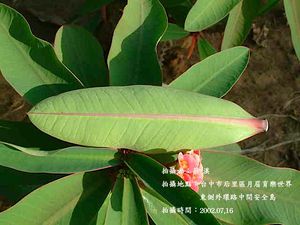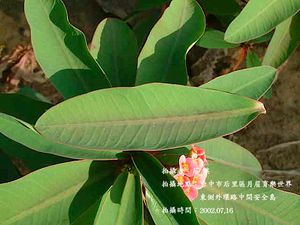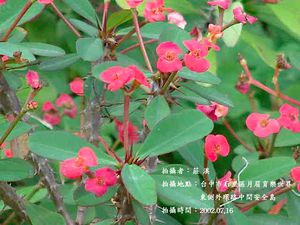麒麟花
出自台灣有毒中草藥毒性資料庫
| 中英文學名 | 科別 | 毒性 | 症狀 |
基本資料
|
科別 | 大戟科 Euphorbiaceae |
|
屬名 | 大戟屬 Euphorbia |
|
中文學名 | 麒麟花 |
|
拉丁學名 | Euphorbia milii Ch. des Moulins, Euphorbia splendens |
|
英文名稱 | Crown of thorns, Coroa de cristo,Bojer’s spurge |
|
中文俗名 | 花麒麟、番仔剌、虎剌花、鐵海棠、萬年刺 |
[1]
植物圖片
|
麒麟花-白 |
麒麟花-紅 |
麒麟花全株 | |
|
麒麟花葉背 |
麒麟花葉正 |
麒麟花 |
麒麟花簡介
麒麟花,原先生長於馬達加斯加島,後被引進在台灣種植,由於外觀特殊,且花色鮮艷可愛,因此常見於庭園景觀或路邊栽種。如同同屬的植物,麒麟花的乳汁也具有強烈的毒性,經研究證實有殺蟲效果﹅促進腫瘤生長﹅增強Epstein-Barr virus early antigen表現的能力及生殖毒性等[2-4]。 。
外觀簡述
|
莖 | 常綠灌木,高1-2公尺,莖幹粗壯,據稜溝,呈暗綠色,密生棘刺;刺黑色,常1.5-2.5公分,底部扁平 |
|
葉 | 單葉,互生,少數,多長在嫩枝頂端,具有短柄或無柄;葉長約2-4公分,寬1-2公分,倒卵形至長橢圓狀篦形,兩面平滑 |
|
花 | 大戟花序,呈聚繖花序狀,具長花軸,軸長2-6公分,長于枝俏葉腋;花苞兩片,對生,卵形,鮮紅色;花期4-10月 |
[1]
產地
主要產地為馬達加斯加,台灣亦有栽種作為庭園景觀植物[1]。
毒性研究
- 麒麟花與其它部分大戟屬植物經研究具有殺蟲的效果,特別是針對蝸牛(Biomphalaria glabrata及Biomphalaria tenagophila),因此在部分國家麒麟花的乳汁萃取液被用來當作環境殺蟲劑,預防經由蝸牛傳染的血吸蟲病。由於是直接將萃取液投放到環境中,因此毒殺的專一性非常重要,Eduardo (2000)即針對毒殺的物種專一性進行了研究,發現麒麟花乳汁的毒殺專一性,相較目前已被認可的同種類殺蟲劑Niclosamide較佳[5]。Schall (2001)也發現不經過濾處理的乳汁抑制蝸牛生長的效果相當良好,且半數致死劑量也相當的低[3]。
- 麒麟花乳汁主要用途為殺蟲劑,經由食物鏈有可能會進入人體內,因此對於生殖毒性的評估相當重要。Souza (1997)經由動物實驗(rat)結果發現麒麟花乳汁口服對於母體的體重﹅吸收/著床率﹅胎兒存活率﹅胎兒重﹅胎兒骨骼重量等都有顯著的上升或下降的現象[4]。
- 在麒麟花乳汁的毒性研究中,Zamith (1996)及Schall (1991)以CHO cell line分別探討乳汁對於基因是否具有毒性,結果顯示並沒有對基因具有顯著強烈的毒性,即使添加了老鼠肝臟萃取物S9,也並沒有明顯地具有毒性的代謝物產生[6, 7]。
- 有毒成份
- Milliamine A, B and C屬於diterpene ingenol類的化合物[8]。
- 中毒劑量
- 不經過濾的麒麟花乳汁投於開放式空間(蝸牛大小約34-37 mm),LD50及LD90分別為0.6及0.83 μg/mL[3]。
- 老鼠經口給藥,新生兒生長遲緩 ≥ 125 mg/kg;胎兒致死劑量 ≥250 mg/kg;胎兒骨骼畸形劑量 ≥250 mg/kg。NOAEL劑量為<125 mg/kg/day,骨骼畸形和致胎兒死亡的LOEL劑量為250 mg/kg/day[4]。
- 將麒麟花乳汁的水萃取液分別投予在 A. 實驗室蝸牛(Biomphalaria glabrata及Biomphalaria tenagophila):LD50 < 0.32 μg/mL,LD90 < 0.45 μg/mL。 B. 野外蝸牛(Biomphalaria tenagophila及Bebistes reticulatus):LD50 < 2.36 μg/mL,LD90 < 4.04 μg/mL[9]。
毒性分級
參考文獻
1. 鄭武燦. 台灣植物圖鑒 上冊. 台北: 茂昌圖書有限公司 2000, p.p.681.
2. Roe FJ, Peirce WE. Tumor promotion by Euphorbia latices. Cancer Research 1961; 21: 338-344.
3. Schall VT, Vasconcellos MC, Rocha RS et al. The control of the schistosome-transmitting snail Biomphalaria glabrata by the plant Molluscicide Euphorbia splendens var. hislopii (syn milli Des. Moul): a longitudinal field study in an endemic area in Brazil. Acta Tropica 2001; 79: 165-170.
4. Souza CA, de-Carvalho RR, Kuriyama SN et al. Study of the embryofeto-toxicity of Crown-of-Thorns (Euphorbia milii) latex, a natural molluscicide. Brazilian Journal of Medical and Biological Research 1997; 30: 1325-1332.
5. Oliveira-Filho EC, Paumgartten FJ. Toxicity of Euphorbia milii latex and niclosamide to snails and nontarget aquatic species. Ecotoxicology and Environmental Safety 2000; 46: 342-350.
6. Schall VT, Vasconcellos MC, Valent GU et al. Evaluation of the genotoxic activity and acute toxicity of Euphorbia splendens latex, a molluscicide for the control of schistosomiasis. 'Brazilian Journal of Medical and Biological Research 1991; 24: 573-582.
7. Zamith HP, Paumgartten FJ, Speit G. Evaluation of the mutagenicity of the molluscicidal latex of Christ's Crown (Euphorbia milii var. hislopii) in mammalian cells in vitro and in vivo. Mutatation Research 1996; 368: 15-20.
8. Hirata Y. Toxic Substances of Euphorbiaceae. Pure and Applied Chemistry 1975; 41: 175-199.
9. de Vasconcellos MC, Schall VT. Latex of "coroa de cristo" (Euphorbia splendens): an effective molluscicide. Memórias do Instituto Oswaldo Cruz 1986; 81: 475-476.
| 中英文學名 | 科別 | 毒性 | 症狀 |
